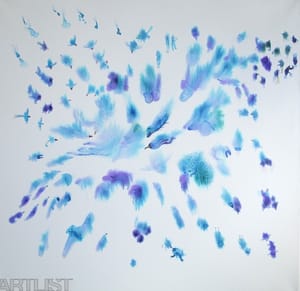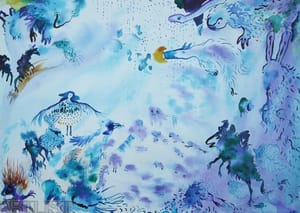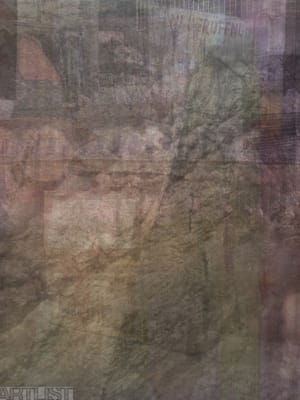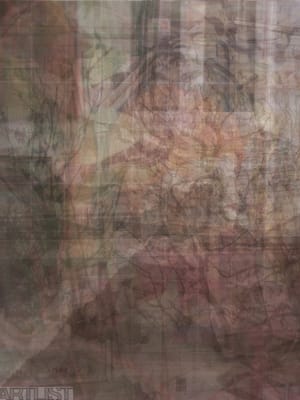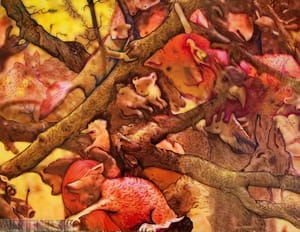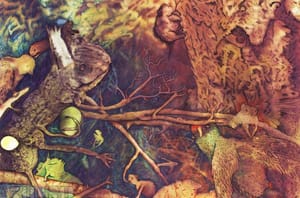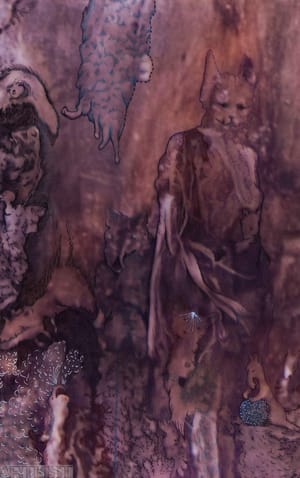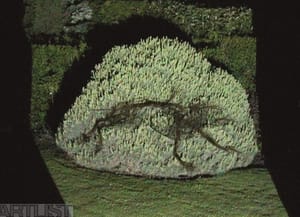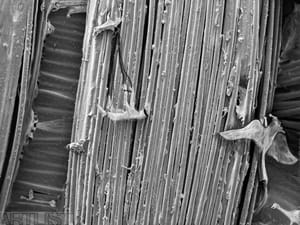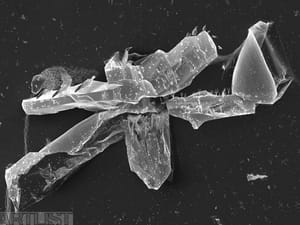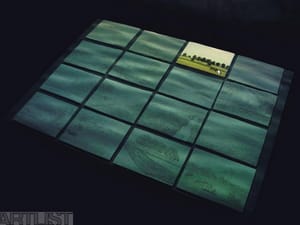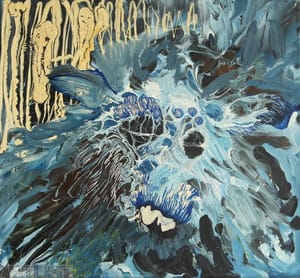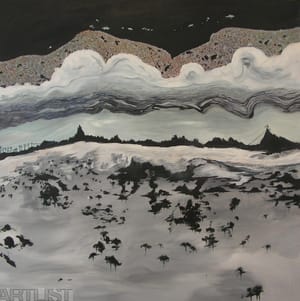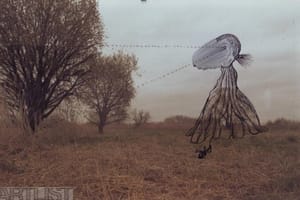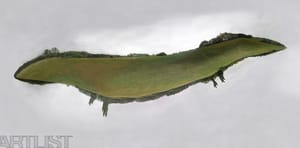- First Name
- Linda
- Surname
- Čihařová
- Born
- 1982
- Birth place
- Prague
- Place of work
- Prague
- Website
- www.lindacihar.com
- Keywords
- CSU Library
- ↳ Find in the catalogue
About artist
The work of Linda Čihařová has a multimedia focus with a wide span of visual expression. She works with new technologies, her projects are conceptual, often on the border of interactive performances. She uses new media in combination with drawing, painting, video and photography. Her basic source of inspiration is landscape and the natural living environment under the influence of human impact, where she discovers various possibilities for inter-class communication. She is also interested in scientific methods during the research of natural and ecological processes.
While Čihařová studied at the Academy of Arts, Architecture and Design in Prague (studio of Adéla Matasová and later studio of Jiří David, 2002-2008) she was influenced by living on the southern periphery of Prague for several years, where she examined her solidarity with the surrounding nature and found answers in her distinctive painting metaphors (series Ecosystems; Ecocreatures, 2003). Her thesis work was the project Emolandscape (2008, exhibition TINA B., Gallery Vernon), expressing the bond of man with landscape in a study of his feelings in nature, where the artist wanted to create emotional typology of the landscape. Based on an interactive video projection she created a map of a landscape 1 km2 large, where the viewers were able to play the video of places of their choice. There were nine places recorded at night time using artificial light – flashlight, car headlights or spotlights from a searching helicopter. After that she created scientific projects such as Streptomyces (2007) from photographs taken in the laboratory of bio-informatics at the Institute of Microbiology of the Academy of Science of the Czech Republic, monitoring regulation processes in cells. Subsequently, she started a new concept of drawing on photographs called Photodrawings (continuing since 2008), where the artist’s fantasy was inspired by landscape details according to which she created mini-stories from certain localities. Drawing became an expression of personal reading in a given environment and she created psychological stories of these places. The most developed form of this concept was the project Migromat, 2009 (Vernon Gallery) – a video poem and interactive installation on the topic of migration in landscape, where, through the movement of man, meanings shift and visual perception changes and images in the human mind are interwoven.
After graduating from the Academy of Arts, Architecture and Design in Prague, Čihařová went to Holland for a study stay, where, inspired by the local landscape, she created in 2009 a video project called Neverlands. It was an installation of 16 ceramic embossed boards, modelled according to various parts of Holland’s landscape, spread on the floor in a way for the viewer to choose and pull out any board from the sub-projection of water above its surface, after a moment, however, it was once again covered by the image of water. In another project called Average Place (2009) she compared visual stimulations of our living environment with the visions in our hearts. An average example was perceived as something that is a specific place and stands out with specific life inside. In her series Nanosociety (2009) she once again confirmed her interest in examining natural phenomena with a scientific base, where this time her inspiration came from photographs from an electron microscope including organic shots all the way to inorganic crystals. These were once again supplemented by drawings which, in the black and white nano-landscapes, evoke shapes of various beings. The artist was given the opportunity to document research done by the Faculty of Chemical technology in Pardubice and South Bohemian University in České Budějovice, which revealed unsuspected matter inside natural structures. This is also where the series Zoom in Scapes (2009) originated as a landscape discovered by realistic images from a microscope. Later the series Morfy (2009) is created from images capturing the correlation of fauna, flora and landscape.
Čihařová’s longing for expression in colour eventually led her to working with watercolour, where she proceeds in a similar way as in her photo drawings or nanosociety – in an abstract foundation she searches for subconscious shapes and stories. Once again she uses combined technique with photography and she engages the viewer in her interactive installations. This concept applies to the current series’ One Family and Metamorfis, which continue to convince us about the never ending potential of transformations in life and in lifeless matter.
- Author of the annotation
- Vlasta Čiháková Noshiro
- Published
- 2012
CV
Studies:
2002-2008 Academy of Arts, Architecture and Design in Prague
1998-2002 Václav Hollar Art School
Stipends:
2009 Egona Schiele Center in Český Krumlov
2007 Academy Beeldene Kunste Maastricht, Netherland
2005 Film and TV School of Academy of Performing Arts in Prague
2005 University of New Mexico, Albuquerque
Exhibitions
- Solo exhibitions
-
2011
Migromat, Galerie Vernon, Praha
2010
Terestrialisti, Golem club, Praha
Výlety pod krajinu, Galerie Greisen, Praha
2009
Neverlands, galerie (A)VOID, Praha
- Group exhibitions not included in ARTLIST.
-
2012
Zelená /Green, Galerie Deset, Praha
Nuit Blanche” ( instalace Treenimal Escape), Brusel
Keramické setkání 2012″ ( instalace Neverlands), Regionální museum v Kolíně
2011-12
From Different Corners“, Galerie kritiků, Palác Adria, Praha; Galerie Bart kunst inhuis v Nijmegen a Amsterdam; Galerie Arteversum, Düsseldorf; Galerie mladého umění,
Štrasburk; Galerie Baeckerstrasse 4, Wien
Trace the tweet Face the speed”, Galerie Školská 28, Praha
Echoflux festival”(instalace Jedna Rodina), Gallery Trafo, Praha
Roppongi Art Night“, Roppongi Hills Centre, Tokio
Umění recyklace”, Galerie umění pro děti, Praha
Krajina magická / Jeden úhel pohledu”, Oblastní galerie v Liberci
2011
VIII. International Biennale of Contemporary Art in Firenze”, Florencie
AMBER festival Datacity, Istanbul
encontres Internationales Paris/Berlin/Madrid“(Centre Pompidou - Paříž, Cine Doré – Madrid)
ENTER multimediale 2011“, Národní technická knihovna, Praha
Zoom In Scapes“ součást projektu GAMA , Fakulta chemicko-technologická, Pardubice
Sklo vyteklo z prasklé vany“ experimentální dokumentární performance, Národní divadlo, Nová scéna, Praha
2010
Mikrosvět II“, Galerie Nahoře, České Budějovice
Hloupé a chytré“, Galerie kritiků, Palác Adria, Praha
Kick the habit“, České centrum, Vídeň
2009
Fotokresby, galerie Vernon, Praha
Urban Kiss, Galerie kritiků, Palác Adria, Praha
Vzkazy říše středu“, galerie Zámecký mlýn, Jindřichův Hradec
Nanoscope, galerie Dox, Praha
Krajina II, klášter Šternberk
Přepnutí hranice“, galerie Trafačka, Praha
2008
Krajina / vycházka“, Lomnice nad Lužnicí, kostel sv. Václava
Ženský aspekt“, galerie v Bílé věži, Hradec Králové
2007
Streptomyces, ENTER 3 Multimediale, Akademie věd ČR
2006
HUMORG, Galerie kritiků, Palác Adria, Praha
2005
INSCAPE. Galerie kritiků, Palác Adria, Praha
2003
Meteor, Nová media, Cheb
- Collections
- Collection of Egon Schiele Centre in Český Krumlov
- Other realisations
Spolupráce s vědeckými laboratořemi a workshopy: Zoom into Scapes – Jihočeská universita v Českých Budějovicích (laboratoř digitálního zobrazování ústavu Akademie věd), Doc. RNDr. František Weyda, CSc Výstava Nanoscope, 2009: spolupráce: Fakulta chemicko – technologická v Pardubicích, Andrea Kalendová, PhD. Výstava – „Infiltrace do Mikrosvěta“: spolupráce Jihočeská universita v Českých Budějovicích (laboratoř digitálního zobrazování ústavu Akademie věd), Doc. RNDr. František Weyda, CSc Festival Enter: spolupráce Institut mikrobiologie – laboratoře bioinformatiky na AVČR, Ing. Jiří Vohradský Ph.D.
Monography
- Monography
Keramické setkání, 2012, text Dita Hálová
Krajina magická, 2012, text Markéta Kroupová
Inscape, 2005, “Humorg” 2006, “Urban Kiss” 2009, “Hloupé a chytré” 2010, From Different Corners, 2011-12, texty Vlasta Čiháková Noshiro
Článek o performanci “Sklo vyteklo z prasklé vany” v New York Times, 2010, Dinah Spritzer
Kick the Habit, 2010, texty Klára Vomáčková, Ula Schneider, Taťjana Langášková
ENTER 3 Multimediale. 2011, text Denisa Kera
